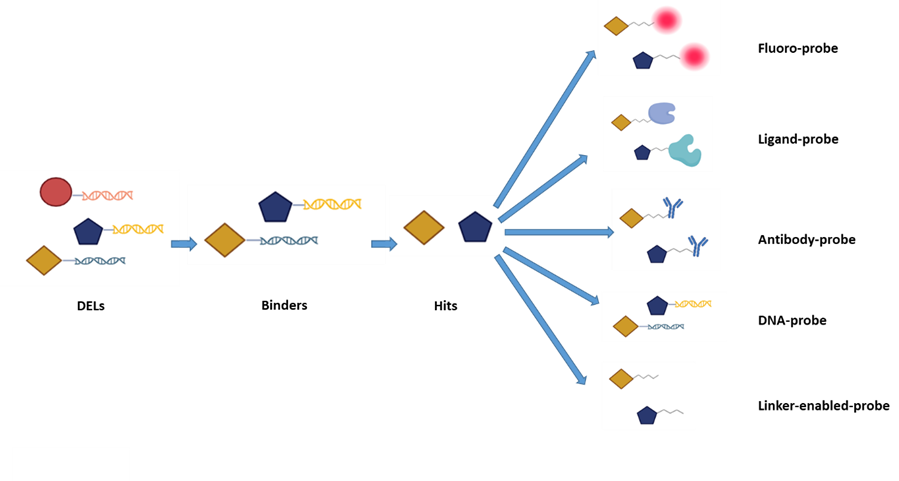Get up to date with the latest HitGen articles and join us in the events
The advancement of DNA Encoded Library (DEL) technology has been significant in recent decades. Beyond its conventional role in small molecule drug discovery, its integration into emerging fields has begun to garner increased interest. This can be attributed to its large chemical space, abundant Structure-Signal Relationship (SSR) data, and inherent DNA conjugation properties. In this context, we will explore alternative applications of DEL technology. It is postulated that with the continuous expansion of the DEL field and technological progression, more applications are yet to be unveiled.
DEL for probe development
Thanks to the vast diversity of DEL, the role of DEL in obtaining new starting points for novel drug development has been recognized well. The rapid on-DNA and off-DNA chemical synthesis methodology established at HitGen not only allows fast DEL design and constructing, but also allowed quick affinity-based assay development in terms of screening and optimization. Compound series identified by DEL screening would guarantee both good potency and known attachment points that have been used for DNA tagging without extra validation effort. For challenging targets with no reported positive binders/inhibitors, any potential binders would be useful not restricted to direct drug development candidate but also can serve as probes for target validation and assay development. With ensured good proximity between DEL compound series as results of DEL screening and combination with various labelling techniques allowed by the known linker attaching points, probe development based on DEL results became promising and efficient.

Figure 1. A schematic workflow for probe development based on DEL screening. Different probes can be developed and used in FRET (Fluorescence Resonance Energy Transfer), BRET (Bioluminescence Resonance Energy Transfer), target fishing, pull down, qPCR (quantitative Polymerase Chain Reaction) assays and etc.
DEL for sensor and diagnostic reagent development
Aptamers have been developed as recognition element for binding and monitoring the change of specific biological molecules. The capacity of DEL to investigate an extensive array of chemical spaces is indisputable, thereby facilitating their contribution to such applications through the identification of molecules that can sense alterations in proteins, peptides, and even small molecules. In addition, disease progression is usually associated with the change of multiple biomarkers or malfunction of various targets, with the rapid and efficient screening of a vast chemical space, DEL is a promising tool to play a significant role in the future of diagnostic reagent development. This can be achieved in the traditional setting of screening against the targets of interest, or more importantly, screen against biological samples, tissues or even in vivo models to identify multiple molecules responding to various targets or a specific disease pattern and phenotype.
DEL for nucleic acid delivery
Nucleic acid delivery on one hand relies on nanoparticles, on the other hand, the utilization of specific receptor mediated internalization represents a delicate strategy. DEL not only provides vast chemical space for the identification of small molecule ligand to these receptors in traditional selection format, the DNA conjugation nature of DEL molecules also offers the benefit of screening DNA delivery directly. The DNA tag of the DEL molecule can serve as the cargo in nucleic acid delivery, and direct cell based internalization selection could help identify receptor mediated nucleic acid delivery reagent directly from the selection.

Figure 2. A schematic example for identifying nucleic acid delivery reagents from DEL selection.
DEL for functional based selection
Currently, the predominant selection method for DELs is based on affinity, however, the functional-based selection of DELs is being recognized as a prospective approach. The One Bead One Compound (OBOC) DEL strategy has been employed in functional-based selection, identifying hits that directly modulate target activity. The application of DEL selection in diverse cell-based methodologies, either by screening against the cell surface target or introducing DELs into the cells, yields hits that exert a biased effect on specific cellular outcomes. By conducting DEL screenings against a distinct phenotype, cellular function, or specific reporting system, investigators can discern compounds that regulate these functions or unveil potential novel targets for pharmacological discovery.
DEL for pesticide development
The use of DEL in pesticide development offers the similar advantages in drug discovery. It allows for the screening of large compound libraries with different conditions investigated in parallel and enables the identification of hits with diverse chemical structures and potentially novel modes of action. Upon rigorous evaluation against human target selection, DEL confers supplementary benefits for attaining selectivity over human homologs in pesticide discovery. The vast chemical space presents the potential for pinpointing unique enzymes in insects or fungi, thereby, mitigating potential environmental pollution issues. By leveraging the power of DEL, we efficiently identified developable hits and optimized the chemical property with improved efficacy, these compounds were further selected as candidates for the pesticide discovery (Figure 3).

Figure 3. Identification of pesticide candidates from DEL selection.
Outlook
With the advancement in scientific research, the trajectory of DEL technology extends beyond the aforementioned applications and the list can go on and on. For example, utilizing the inherent properties of DEL molecules such as DNA attachment, DELs hold potential utility in the development of Antibody-Drug Conjugates (ADCs). This utility applies not only in the identification of novel cytotoxic agents, but also in offering supplementary data pertaining to linking and conjugation. Moreover, DELs serve as a robust approach for profiling target ligandibility. It facilitates the acquisition of critical information concerning the nature of molecules interacting with targets and the mapping of various target binding sites. Concurrently, the extensive datasets derived from DEL selection can be employed in the training of Artificial Intelligence (AI) models, thereby assisting in the design of innovative molecules. It is anticipated that numerous novel applications will emerge in the near future and we are excited to witness the forthcoming applications of DEL.
We use cookies to provide a better web experience.
By using our site, you acknowledge our use of cookies and please read our Cookie Notice for
More information